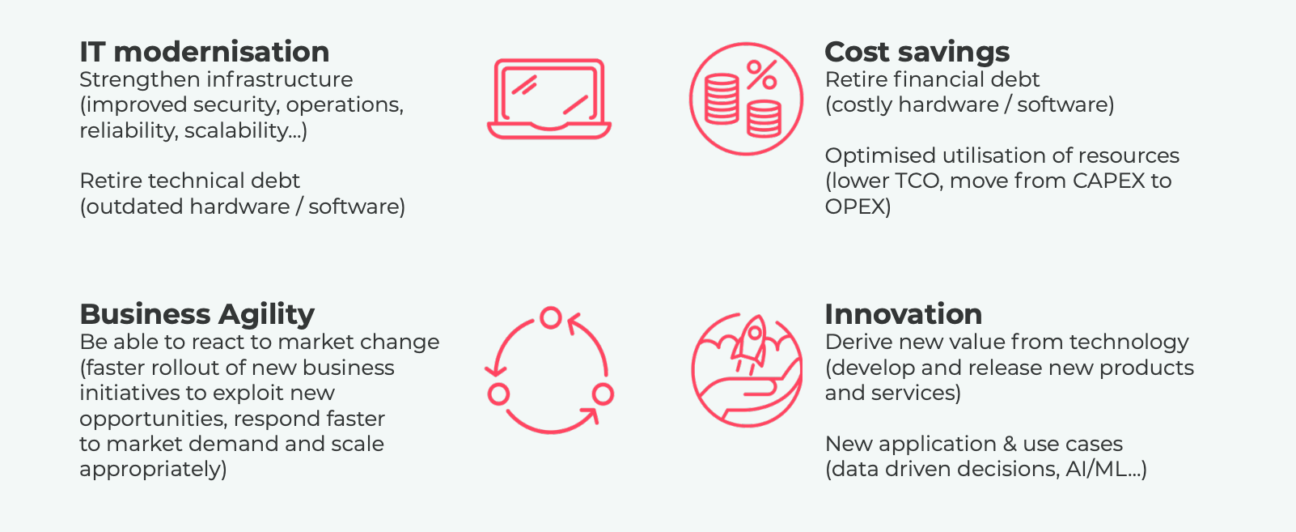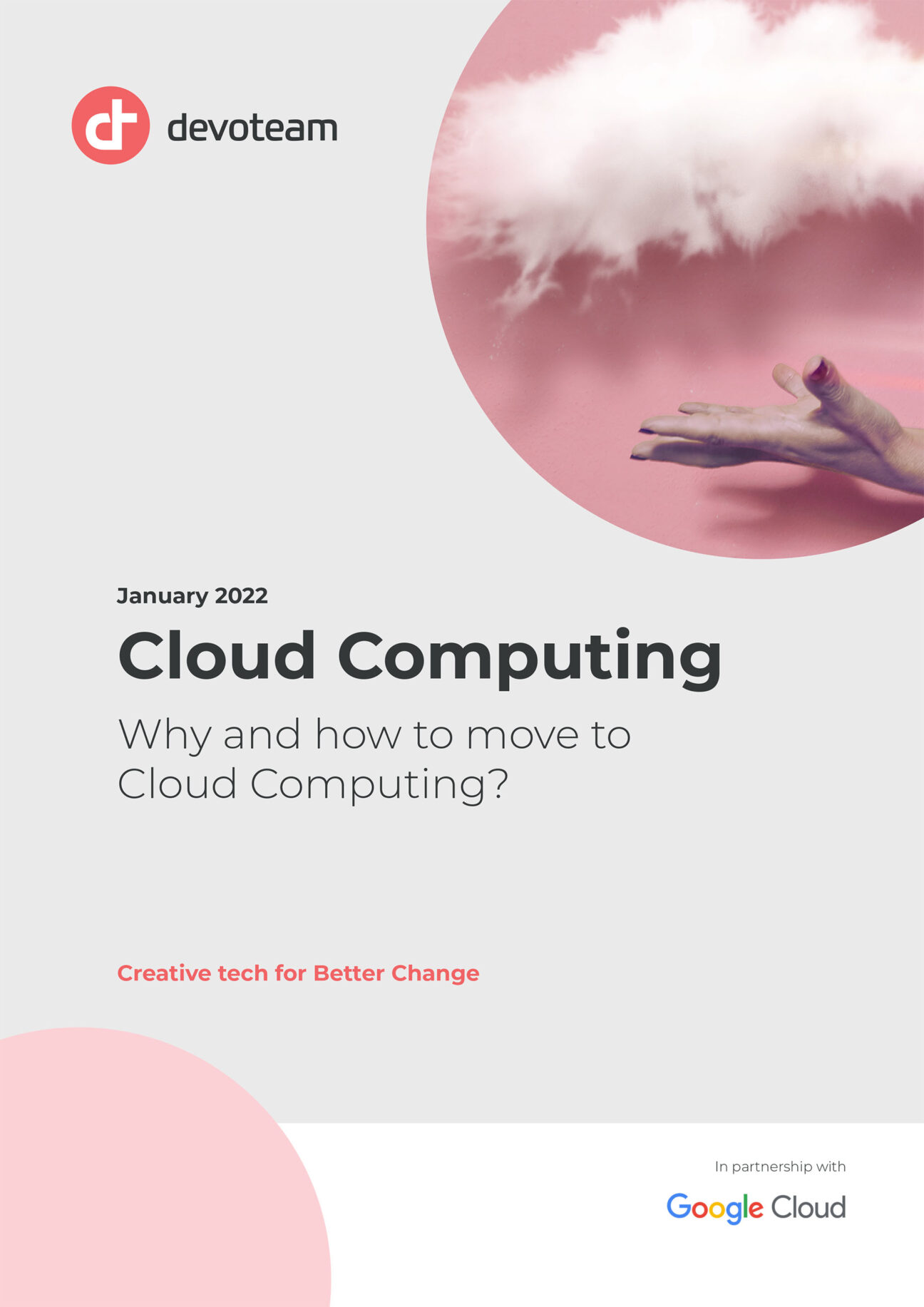In this chapter you’ll read about:
- Innovation: benefit from the latest technological advancements.
- Modernisation of IT systems: see improvements in infrastructure and its uses.
- Reduce operating and infrastructure costs
- Gain business agility by deploying resources faster
In 2021, Cloud Computing is no longer just an ambition or a futuristic project for organisations, but a reality. It is a daily reality for small and large companies, regardless of their business sector. Initially focused on niche issues some fifteen years ago (backups, storage, internal applications, etc.), migrations have multiplied to include business-critical applications.
Why? “When we asked our customers, we realised that the reasons are often the same,” explains Nicolas Sarrazy, Google Cloud Platform Lead at Devoteam G Cloud. “The main reason is the need to innovate. Today, a company that doesn’t question itself and doesn’t shake up its business model is putting itself in danger. You have to be able to adapt in record time. This implies true business agility based on modern IT and adaptation of costs to use.”
Why are our customers moving to the Public Cloud?

Innovate: benefit from the latest technological advances
“Create new products in a much more straightforward, regular and fast way.”
In order to stand out from the crowd, or simply to meet increasingly tight time-to-market requirements, organisations need to offer their customers and employees modern, and sometimes even cutting-edge, tools. The advantage is that today, in order to use these advanced technologies, it is no longer necessary to invest a huge budget upstream and to acquire internal skills. For example, for a company to develop solutions using machine learning requires not only an extremely large volume of data but also a team of highly skilled Data Scientists to create models, train them and optimise them.
In their offers, Cloud providers now make available to companies, on a pay-as-you-go basis, turnkey off-the-shelf offers for data, image, video and voice analysis using artificial intelligence, character or facial recognition, etc. Moving to the Cloud clearly makes it much simpler and easier to create new products.
Upgrading your IT system: improving your infrastructure and applications
“Get rid of this obsolescence management of their IT infrastructure forever”
While the use of Cloud Computing is an excellent opportunity to access the best of technology, it also indirectly enables the removal of a technical debt that many companies have accumulated for too long. By switching to the Cloud, companies are indeed drawing a line under an internal infrastructure made up of hardware and software that is often outdated and, moreover, is often no longer supported by the manufacturers.
With Cloud Computing, the supplier takes care of hardware maintenance, including software and the OS layer for certain managed services. “This is a unique way of freeing companies from managing the obsolescence of their IT infrastructure forever,” confirms Nicolas Sarrazy. While it is, first and foremost, an opportunity for companies to rationalise their software and hardware assets, Cloud Computing also makes it possible to improve security, streamline and strengthen operations and increase the resilience of environments along with their scalability.
No more applications that crash at the slightest peak load! Thanks to the flexibility of the Cloud, the infrastructure automatically resizes itself on demand, upwards or downwards, to meet the company’s needs as closely as possible. No loss, no surplus.
Reduce operating and infrastructure costs
“Significant earning potential”
Another direct outcome of this migration is the financial aspect. In fact, in the same way that technical debt is removed, financial debt is also removed. The maintenance of hardware or applications is indeed extremely heavy, with additional costs as soon as the systems are dated. Switching to the Cloud represents a significant cost reduction for the company, which is thus freed from part of its IT management.
In addition, the flexibility of the Cloud, as we have mentioned, allows the company to pay only for the resources used. For example, for financial systems that run once a month or even once a quarter, for development and test environments that are not used at night or on weekends, or for e-commerce sites that need servers capable of supporting a very specific load peak such as Christmas or Black Friday. Behind this, the simple fact of turning off applications used during normal business hours can save up to 60% !
Gain business agility by deploying resources faster
“Faster product launches and the ability to adapt more quickly to the competition”
Scalability and the dynamic pricing model allow the overall TCO to be lowered and IT investments to be valued. We move from an investment model (CAPEX) to an operational expenditure model (OPEX).
The company can thus be much more responsive to market changes: it can, for example, release new applications, new offers or be on the lookout for new opportunities much more easily. It can also work from digital twins accessible by the entire supply chain and reduce the processing time in prototyping cases from 6 months to 3 weeks.
The company can also manage over time by starting small and scaling up in a completely transparent way. Until now, launching a new product or project required rapid IT investments, hardware procurement and, in the case of scaling up, the addition of servers. A launch could only be done gradually, requiring numerous approval cycles. Today, after its launch, an application adapts and evolves automatically.
Why should you migrate now?
Talent attraction
One thing is certain: without young talent, innovation is not possible! We don’t attract them with outdated technologies; this generation wants to work in modern environments in which they have also been trained. They have built themselves up with it, we will not make them go back!
Better security
CISOs now recognise that vendors’ security resources exceed their own. 80% of technical managers say their organisations are struggling to build a robust defence.
Optimised Time-to-Market
Deliver new products and features to develop a competitive advantage and respond quickly to customer needs. The cloud can reduce time to market by up to 55%.
Improved performance
Improved performance and availability of applications even during peak loads remain the top criteria for cloud adoption, with over 40% of companies saying they choose the public cloud for these reasons
Reduced operating costs
Several studies show that the Cloud can save up to 55% compared to a traditional on-premise infrastructure. And that’s only part of the gain, the majority of which is in operational gains (40-55% increase in operational efficiency on the platform, 60-96% improvement in security task productivity and 23-38% reduction in developer time spent on non-coding activities).
